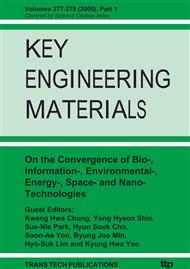p.45
p.51
p.56
p.62
p.67
p.72
p.77
p.82
p.90
Production and Amyloid Fibril Formation of Recombinant Yeast Prion(Sup35)-Like Protein Fragment
Abstract:
Amyloid fibrils have long been established as the well-known a-helix to b-sheet transition that characterizes the conversion of the cellular form of prion proteins into a scrapie form. A very short sequence of the Yeast prion-like protein GNNQQNY(SupN) is responsible for the aggregation that induces diseases. As such, in the current study, a GST-fused monomer SupN vector is used to express the SupN peptide in Escherichia coli(E. Coli). In addition, a method for the production, purification, and cleavage of the recombinant SupN in E. coli is also described, which yields as much as 2mg per liter of growth of natural abundance fusion proteins in LB media. To gain a better understanding of the aggregation-structure relationship of the 7 residues of the Yeast prion-like protein, the change in the conformational structure is studied by Transmission Electron Microscopy and will be further studied by 13C solid-state NMR. Accordingly, this is the first investigation of the fibril formation of a heptamer peptide expressed in E.coli.
Info:
Periodical:
Pages:
67-71
Citation:
Online since:
January 2005
Authors:
Price:
Сopyright:
© 2005 Trans Tech Publications Ltd. All Rights Reserved
Share:
Citation:


